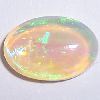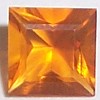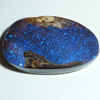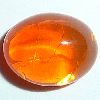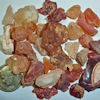

Opal doesn't really fall in the category of a precious gem because of its low hardness and ambiguous mineral composition, but we let it in because it's so beautiful. There is quite a range of varieties from "common" to "precious". Common Opal was historically not considered for jewelry but that has changed with the discovery of beautiful transparent and colorful varieties. Precious Opal is the material famous for its "play of color" and the intensity of that characteristic is what drives the demand.
Common Opal is found everywhere, most of which is Leaverite ("Leave it right there"), but a significant source of gemmy common Opal is the orange and red material found in Mexico. This material can have color play but most is just rich colored transparent material suitable for faceting. Precious Opal comes mostly from Australia, but can be found in smaller quantities in many other places. Most varieties are categorized by their body color and/or their source. The price is determined primarily by the intensity of color play, but some credit is given to the rarity of the source, its stability and the longevity of its life.
Opal is one of very few gemstones that has a lifespan. The question is never "if" but "when" an Opal will deteriorate. This is mostly due to the fact that Opals have a significant amount of water in their structure. Most Opals are 5% and 10% water. As the water escapes over time, the color play and integrity of the stone suffer. This causes the Opal to lose "fire", turn milky and often crack or "craze". Sometimes these effects can be "healed" by adding moisture, but most often the original beauty is irrecoverable. To extend the life of an Opal, proper care should be taken to reduce the exposure to hot and dry environments.
Cutting Opal is also tricky. The rough must be properly dried or "stabilized" before work can be done. There is usually a significant yield loss in this step since much material will fall vulnerable to crazing within a month or so. This risk is why so many amazing Opals never escape the water filled glass jars they are stored in. Once the material has been dry long enough for the cutter to feel comfortable the remaining rough will remain stable for years, he can start grinding. This introduces its own risks. Most of the color play in Opal is found in thin elusive layers of the material and the cutter must find and/or maintain it. That is why most Opal is cut into freeform cabochons so the lapidary can work around the color play. The cutter must be very careful to not grind away all the best color play. Many fine Opals are now dust on the workshop floor.
However difficult an Opal is to find, maintain and cut, the rewards can be unbelievable. There's nothing in the gem world even close to the "fire" and beauty of a fine precious Opal. But that is also why the price for the best pieces can be quite high. A lapidary might have worked kilos of material to get one super piece. Find it and do the work yourself and you can own something amazing for almost nothing. Buy it finished and you're paying for hours of labor and kilos of yield loss. Either way, wear it and enjoy it while you can. It won't last forever.
